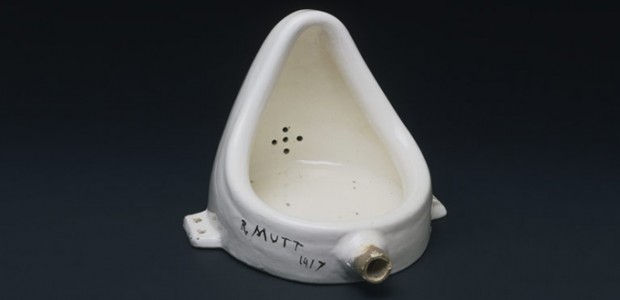You have no items in your cart. Want to get some nice things?
Go shopping
It was by a twist of fate that I began drafting this on April Fool’s Day, that most irritating of days on which you cannot tell whether or not you’re being taken for a numpty. On this day, of all days, I started writing this review of an exceptional art show – one that appears to be built upon a big old practical joke.
The centerpiece of this exhibition, The Bride and the Bachelors: Duchamp with Cage, Cunningham, Rauschenberg and Johns at Barbican Gallery, is a urinal. Today it is probably the most recognisable urinal in the entire world, mind; the Taj Mahal of toilet appliances, really. But a urinal nonetheless. Fountain (1917) is one of the most iconic pieces of twentieth-century art, and arguably afforded Marcel Duchamp, the Francoavant-garde artist of the New York scene, much of his renown. But it’s less the pristine white of the porcelain or the cryptic inscription “R. MUTT 1917” carved into its side that makes this receptacle for wee all that it is. It’s the fact that with it, Duchamp revealed something particular about the art world – and perhaps changed it forever.
Cast your mind back to 1917. After lunching with some friends, a fellow purchases a urinal from a New York supply shop. He sets it on its side, signs it with a name that is not his, and perhaps dusts his hands off with satisfaction. He enters it into a putatively “open” art competition, and the powers-that-be choose not to exhibit it. A letter defending “Mr. Mutt” and his work is published in an art journal, and Fountain becomes the most controversial bathroom fixture of past, present, and probably, future.
Indeed, Duchamp’s prank and the polemic that surrounded it caused a step-change in the history of art. It was a whoopee cushion placed squarely under the bottoms of the exhibition’s organisers, who had opted to run something so absurd as an “open” art competition. That a plumbing fixture would not be displayed, though duly signed and dated, demonstrated the irrelevance of the idea of art as “democratic”. Duchamp’s pissoir thereby exposed the museum as an aesthetic regime that decides what is and is not art, rather than giving the privilege to the artist him or herself.
Duchamp went on to inspire successive artists by – whether intentionally or not – revealing the tension between all-hallowed art and the ordinary. He did this most notably with his “readymades”, or art created from found or mass-produced objects, like Fountain. One can see this theme running through the work of the four American artists currently on show alongside Duchamp at the Barbican: composer John Cage, choreographer Merce Cunningham, and visual artists Robert Rauschenberg and Jasper Johns. Johns, for instance, used pre-existing symbols, like flags and numbers – “things the mind already knows”, in his works. Similarly, Cage used sounds from the everyday – even silence, as in his composition 4’33″.
Albeit reworked for the occasion, Cage’s famous mute piano here figures within a soundscape created by French artist Philippe Parreno, one of the minds behind the exhibition. Guiding visitors through this extensive show are varied sounds ebbing, flowing and sometimes overlapping. Some are readily recognisable from the daily life of a Londoner, such as the sounds of vehicles roaring through the Barbican tunnel below. Some are less so, like the honeyed woman’s voice calling out a captivating anti-melody, drawing listeners further in with every cacophonous tone. At one end of the room, a piano begins to play itself, as lights eerily dim and brighten. Later, the sound of footfall fills the room as dancers bring Cunningham’s choreography to life.
Simultaneously seamless and dissonant, Parreno’s soundscape is a most appropriate accompaniment to the work of Duchamp and his American counterparts. Theirs together is work of confusion, of contradiction, but also a kind of coalescence in its refusal to fall together. The exhibition includes sections on chess, on chance, on presence and absence; there’s all of sound, silence, stillness and movement on display. The Barbican unites these very different artists’ very different works, and dares the viewer to seek some greater meaning.
Exhibiting the oeuvres of these five artists, Barbican gallery has chosen to display the traditionally beautiful in the same light as the banal. It did so perhaps to examine the challenge posed to aesthetic prejudices that “Mr. Mutt” dared to raise back in 1917. Art as technically impressive as Duchamp’s Bride and as hilariously dull as Bottle Dryer, for instance, hang against the same gallery walls; dancers execute with the greatest of poise and elegance what looks like a rendition of the much-abused disco step, The Robot. These challenges get many fired up, as they throw down some troublesome questions. If that urinal is art, is this one art too? If a “readymade” is ready-made, at what point does it become worthy of exhibition rather than weeing in?
Not surprisingly, more than one artist has attempted to urinate into copies of Duchamp’s Fountain since the first one was exhibited. The most recent pair insinuated that they were simply adding to it, and that Duchamp would have approved of their act – one which would appear to most a patent act of vandalism. It’s a troubling thought that art can be democratic, lest we open the flood gates and let iconoclasm rush in. Do all these artists have a point, I wonder? Or were they just taking the proverbial pee?
The debate on what is and isn’t art gets regular rehashing in the media, popular culture, and creative spaces; and all the while we – the art establishment and the gallery-going public – retain our prejudices and our pretenses at exclusivity. Duchamp might have been aware of the art world’s paranoia, and that of the wider public, of being fooled; and with some of his work, he may have just been poking a bit of fun at it.
There’s a joke about Leonardo da Vinci, the Renaissance inventor with whom Duchamp is often likened; I now can’t remember what made it funny but the thrust of it was as follows. Though a card-carrying genius, inventing the airplane engine centuries before the word “airplane” would be used in common parlance must have made da Vinci look a little bit potty. It seems to me that while Duchamp had the metaphorical engine down pat in his time, we’re still working on the airliner. Duchamp and his mates probably wouldn’t have cared if the rest of us didn’t “get it”. All the better if not, I’d think, as it’s us who are really the punchline.
The Bride and the Bachelors: Duchamp with Cage, Cunningham, Rauschenberg and Johns is on at Barbican Gallery, London EC2Y 8DS, until 9 June 2013.

About Sandra Smiley
Sandra spends her days working in PR and moonlights as a feature writer and blogger. You can follow her on @sandraqsmiley.




